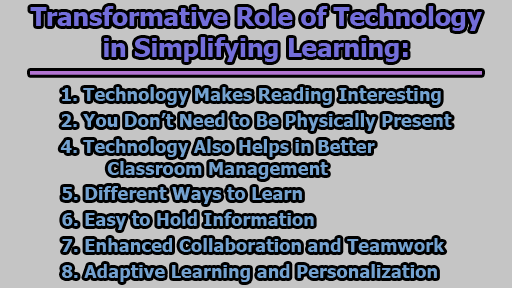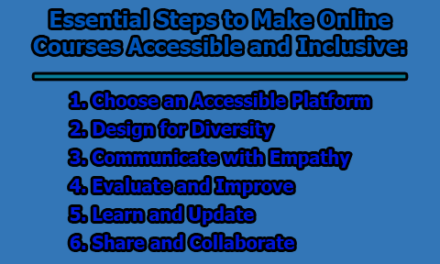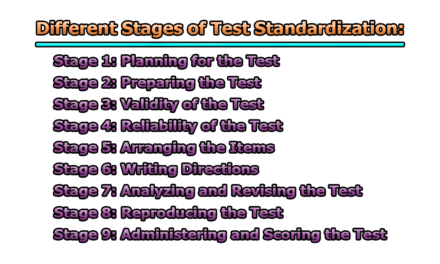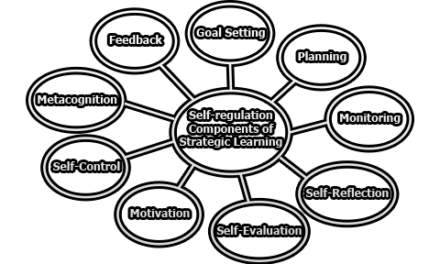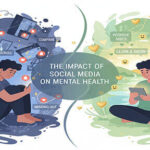Transformative Role of Technology in Simplifying Learning:
In the rapidly evolving landscape of education, technology has emerged as a powerful catalyst, revolutionizing the way we learn and teach. The integration of technology in education has not only simplified the learning process but has also made it more engaging, accessible, and efficient. This transformation is evident across various facets of education, from traditional classroom settings to online platforms. In this exploration, we delve into the transformative role of technology in simplifying learning, with a focus on its capacity to make reading interesting, eliminate physical constraints, facilitate interaction, enhance classroom management, provide diverse learning avenues, and streamline information retention.
1. Technology Makes Reading Interesting: One of the notable ways technology simplifies learning is by making the process of reading more interesting and dynamic. Traditional textbooks are gradually being replaced by e-books, interactive multimedia, and educational apps. These digital resources incorporate features such as animations, videos, and interactive quizzes, turning passive reading into an engaging and immersive experience. Augmented reality (AR) and virtual reality (VR) applications further elevate the reading experience, transporting learners to virtual worlds that bring the content to life. This not only captures the attention of students but also caters to different learning styles, making educational content more accessible and enjoyable.
2. You Don’t Need to Be Physically Present: Technology has shattered the barriers of geographical constraints, allowing learners to access educational resources and interact with instructors without the need for physical presence. Online learning platforms, video conferencing tools, and collaborative software enable students to participate in courses and engage with educational content from virtually anywhere in the world. This flexibility is particularly beneficial for individuals with diverse schedules, geographical remoteness, or other constraints that hinder traditional attendance. As a result, technology fosters inclusivity and democratizes education, providing opportunities for a broader and more diverse range of learners.
3. It Helps in Interacting: Interactivity is a key component of effective learning, and technology facilitates this in numerous ways. Online forums, discussion boards, and social media platforms create virtual spaces for students to interact, share ideas, and engage in collaborative learning. Live chat features during online lectures enable real-time communication between students and instructors, fostering a sense of community despite physical separation. Additionally, interactive simulations and educational games offer hands-on experiences that enhance understanding and retention. By providing avenues for active participation, technology transforms learning from a passive endeavor into a dynamic and engaging process.
4. Technology Also Helps in Better Classroom Management: Traditional classroom management can be a challenging task for educators, but technology offers tools and solutions to streamline this process. Learning management systems (LMS) enable teachers to organize and distribute resources, assignments, and assessments efficiently. Automated grading systems reduce the administrative burden on educators, allowing them to focus more on personalized instruction and student engagement. Moreover, digital communication tools, such as emails and messaging platforms, facilitate seamless communication between teachers, students, and parents. By automating routine tasks and enhancing communication, technology contributes to a more organized and efficient classroom environment.
5. Different Ways to Learn: Technology provides a plethora of options for learning, catering to diverse learning styles and preferences. Whether it’s through visual aids, auditory content, interactive simulations, or hands-on activities, technology offers a variety of approaches to suit individual needs. Online courses, webinars, and virtual classrooms provide alternatives to traditional lecture-based learning, allowing students to choose the format that aligns with their learning preferences. Adaptive learning platforms use data and analytics to tailor content to the individual pace and level of each student, ensuring a personalized and effective learning experience. The availability of diverse learning modalities empowers learners to take control of their education and pursue paths that resonate with their unique strengths and preferences.
6. Easy to Hold Information: The ease of information accessibility is a significant advantage of technology in education. With a few clicks, learners can access a vast reservoir of information on any topic imaginable. Online libraries, databases, and academic journals provide a wealth of resources that supplement and enrich traditional course materials. Search engines and educational apps facilitate quick and targeted information retrieval, empowering students to delve deeper into subjects and explore related concepts. This not only broadens their knowledge base but also nurtures a culture of continuous learning. The convenience of accessing information at one’s fingertips encourages independent inquiry and self-directed learning, skills that are invaluable in the ever-evolving landscape of the 21st century.
7. Enhanced Collaboration and Teamwork: Technology fosters collaboration and teamwork among students, even in virtual environments. Cloud-based platforms and collaborative tools enable students to work on projects, share documents, and communicate seamlessly in real-time. Video conferencing and screen-sharing capabilities enhance the collaborative experience, allowing students to engage in group discussions, presentations, and problem-solving activities. These collaborative technologies mirror real-world work environments, preparing students for the collaborative nature of many professions. By facilitating teamwork, technology not only enhances the learning experience but also cultivates essential interpersonal and communication skills.
8. Adaptive Learning and Personalization: Adaptive learning technologies leverage algorithms and data analytics to tailor educational content to the specific needs and abilities of each learner. These systems adapt the pace, difficulty, and style of instruction based on individual performance, ensuring that students receive personalized learning experiences. Adaptive learning platforms assess students’ strengths and weaknesses, providing targeted interventions to address areas of struggle and offering advanced content for those who progress rapidly. This personalized approach maximizes the effectiveness of instruction, catering to the unique requirements of each learner and promoting a deeper understanding of the subject matter.
In conclusion, the integration of technology into education has significantly simplified the learning process, marking a paradigm shift in traditional teaching methods. From making reading more engaging to eliminating the need for physical presence, facilitating interaction, and enhancing classroom management, technology has become a cornerstone of modern education. The diverse ways in which technology supports learning, such as providing various learning modalities, easing information access, and fostering collaboration, underscore its transformative impact on education.
As we look to the future, the continued evolution of technology promises even more innovative approaches to learning. Artificial intelligence, augmented reality, and immersive technologies are poised to further revolutionize the educational landscape, offering unprecedented opportunities for personalized and engaging learning experiences. However, it is essential to approach this technological integration with a mindful balance, ensuring that it complements and enhances, rather than replaces, the human elements of education. With thoughtful implementation and ongoing advancements, technology will undoubtedly continue to simplify learning, making education more accessible, engaging, and effective for learners worldwide.

Library Lecturer at Nurul Amin Degree College

